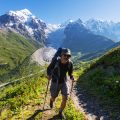Introduction to Leave No Trace and Public Lands
When we set out on a mountain trail, gaze across a high desert plateau, or relax beside a crystal-clear alpine lake, we are stepping into the heart of America’s public lands. These wild and beautiful places—national parks, forests, wilderness areas, and more—are treasures that belong to everyone. But with this shared ownership comes a shared responsibility: keeping these landscapes healthy for future generations. This is where the Leave No Trace (LNT) principles come into play.
What Are Leave No Trace Principles?
The Leave No Trace principles are a set of seven guidelines designed to minimize our impact when enjoying the outdoors. Rooted in American outdoor culture and developed by outdoor educators in the 1980s and 1990s, LNT has become the gold standard for responsible recreation across the United States. They aren’t just rules—they’re a mindset that encourages us to be thoughtful visitors, preserving both the beauty and integrity of our public lands.
The Seven Principles of Leave No Trace
| LNT Principle | Description |
|---|---|
| 1. Plan Ahead and Prepare | Know before you go: research your destination, pack smart, and prepare for emergencies. |
| 2. Travel and Camp on Durable Surfaces | Stick to established trails and campsites to avoid trampling fragile habitats. |
| 3. Dispose of Waste Properly | Pack it in, pack it out—even food scraps and biodegradable items. |
| 4. Leave What You Find | Preserve history and nature; don’t pick flowers or take rocks as souvenirs. |
| 5. Minimize Campfire Impact | Use a camp stove when possible; keep fires small and only in designated areas. |
| 6. Respect Wildlife | Observe animals from a distance; never feed them. |
| 7. Be Considerate of Other Visitors | Keep noise down, yield on trails, and respect everyone’s experience. |
The Significance of Protecting Public Lands
America’s public lands are more than scenic backdrops—they are living ecosystems, cultural landmarks, and spaces for adventure and solitude. Over the decades, these lands have seen increasing numbers of visitors seeking connection with nature. While this love for the outdoors is a positive force, it can also lead to issues like overcrowding, trail erosion, littering, and wildlife disturbance if not managed carefully.
The Balancing Act: Access vs Environmental Impact
The challenge we face is finding balance: ensuring everyone has the chance to enjoy public lands while protecting these places from being loved to death. Permits have emerged as one tool in this balancing act—a way to manage visitor numbers, reduce environmental strain, and uphold Leave No Trace values in practice. As we explore further, we’ll see how permits play an essential role in keeping our wild places wild—for today’s adventurers and tomorrow’s dreamers alike.
2. The Increasing Popularity of Outdoor Recreation
America’s Growing Love for the Outdoors
Across the United States, more people are heading outside than ever before. From national parks to neighborhood trails, outdoor recreation is booming. Activities like hiking, camping, trail running, and mountain biking have seen a surge in participation, especially after 2020 when people sought fresh air and open spaces. This trend isn’t just about adventure – it’s about finding peace, connecting with nature, and spending time with friends and family.
Benefits of More People Getting Outside
Getting outdoors offers a lot of positives for individuals and communities:
| Benefit | Description |
|---|---|
| Mental Health Boost | Nature helps reduce stress, anxiety, and depression. |
| Physical Fitness | Hiking, biking, and walking improve heart health and strength. |
| Community Building | Shared outdoor experiences bring people together. |
| Environmental Awareness | Spending time outside inspires care for natural spaces. |
The Flip Side: Challenges of Increased Access
With more boots on the trails and tents in the campgrounds, our wild places face new pressures. Some of the main issues include:
- Crowding: Popular spots can get packed, making solitude harder to find.
- Trail Erosion: Heavy foot traffic wears down paths and damages plants.
- Litter & Waste: Not everyone packs out their trash or follows Leave No Trace principles.
- Wildlife Disturbance: More people means more chances of disrupting animal habitats.
- Poorly Managed Access: Without permits or limits, sensitive areas can be loved to death.
A Quick Look at Outdoor Participation Numbers
| Activity | % Increase Since 2019* | Most Popular Regions |
|---|---|---|
| Day Hiking | +35% | West Coast, Rocky Mountains, Appalachians |
| Camping (All Types) | +25% | Southeast, Midwest, Pacific Northwest |
| Biking (Trail/MTB) | +22% | Northeast, Southwest, California |
| Paddling (Kayak/Canoe) | +18% | Lakes Region, Coastal Areas |
| *Source: Outdoor Industry Association reports from 2019-2023. | ||
Navigating the Balance Between Access and Impact
This rise in outdoor activity is both exciting and challenging. It calls for thoughtful planning to ensure that everyone can enjoy wild places—now and for generations to come—while protecting the landscapes we love. That’s where permits and Leave No Trace ethics start to play a crucial role in shaping the future of America’s great outdoors.

3. Understanding Permits: Types and Purposes
The Landscape of Permits in American Outdoors
When exploring America’s legendary wild places, you might notice that certain trails or parks require permits. While it may seem like extra red tape, these permits play a vital role in balancing our desire to experience nature with the need to protect these special environments for future generations. Let’s break down the different types of permits and how they help manage both access and impact.
Main Types of Outdoor Permits
| Permit Type | Where You’ll Find It | Main Purpose |
|---|---|---|
| Wilderness Permit | Yosemite, Glacier, Olympic National Parks, and more | Controls overnight use in designated wilderness areas to preserve solitude and limit human impact |
| Backcountry Permit | Grand Canyon, Zion, Rocky Mountain National Parks | Regulates multi-day trips in remote areas; helps monitor resource use and safety |
| Day-Use Permit | Mt. St. Helens summit, The Wave in Arizona, some popular trailheads | Limits daily foot traffic on heavily visited trails or fragile landscapes |
| Campsite Reservation Permit | Many national parks (e.g., Yellowstone, Shenandoah) | Assigns specific campsites to avoid overcrowding and reduce environmental strain |
| Special Use Permit | Group events, guided tours, research activities across various public lands | Ensures large gatherings or unique activities don’t overwhelm natural resources |
How Permits Help Iconic American Landscapes Thrive
Visitor Numbers: By capping how many people can enter a sensitive area each day or season, permits prevent trails from turning into highways. Think about Half Dome in Yosemite—without a permit system, the cables would be jammed and the wilderness feel would vanish.
Ecosystem Protection: Limiting numbers gives plants, animals, and soils room to recover between visits. In places like the Boundary Waters Canoe Area or Denali’s backcountry zones, this means fewer muddy trails and healthier wildlife.
User Education: Many permits come with Leave No Trace reminders or even quick orientation sessions. This helps first-time visitors understand how to minimize their footprint—like packing out trash or sticking to durable surfaces.
Safety: By knowing who is out there and when, rangers can better respond to emergencies and keep track of usage patterns that might point to new risks.
The Takeaway: Permits as Tools for Stewardship
No matter where your adventure takes you—from the granite peaks of the Sierra Nevada to the deep canyons of Utah—a permit isn’t just a piece of paper. It’s a key part of protecting America’s wild heart for everyone who comes after us.
4. Balancing Access with Conservation Needs
Permit systems have become essential tools for outdoor recreation areas across the United States, especially in popular national parks and wilderness zones. These systems are designed to strike a careful balance—allowing people to enjoy nature’s wonders while protecting fragile ecosystems from overuse. Understanding how permits work helps us see why they matter, both for adventurers and for the landscapes we love.
How Permit Systems Work
Permits limit the number of people entering certain backcountry trails, campsites, or climbing routes each day. This control keeps visitor numbers at sustainable levels, reducing soil erosion, wildlife disturbance, and trail damage. It also preserves that special feeling of solitude and wildness that many seek when heading into remote areas.
What Are Permits Trying to Balance?
| Access Goals | Conservation Goals |
|---|---|
| Letting more people enjoy natural spaces | Protecting habitats from overcrowding and harm |
| Supporting outdoor recreation and education | Maintaining healthy plant and animal populations |
| Encouraging inclusive experiences for all visitors | Preserving the sense of wilderness and peace |
The Visitor Experience: More Than Just a Number
A permit system isn’t just about limiting numbers—it’s about shaping a positive experience. When fewer people share a trail or campsite, it’s easier to follow Leave No Trace principles. There’s less litter, less noise, and more opportunities to spot wildlife. Plus, rangers can provide better guidance and support to smaller groups, making everyone safer and more informed about minimizing their impact.
Common Permit Systems in the U.S.
- Lotto-based Permits: Like the Half Dome hike in Yosemite, where hopeful hikers apply months in advance.
- First-come, First-served: Some wilderness areas release a set number of permits each morning at ranger stations.
- Quota Systems: Parks like Zion limit daily entries to preserve delicate slot canyons or river corridors.
- Seasonal Closures: Certain trails close during sensitive wildlife breeding seasons or recovery periods.
This approach gives everyone—from seasoned backpackers to first-time campers—a fair chance while ensuring America’s wild places remain healthy for generations to come.
5. Controversies and Community Perspectives
The Permit Debate: Who Gets In?
Permits are designed to protect natural spaces, but they often spark heated debates within the outdoor community. At the heart of the conversation is a simple question: Does requiring permits help everyone enjoy nature, or does it keep some people out? Lets break down some of the main issues people talk about.
Equity and Accessibility Concerns
Not everyone experiences permits the same way. For some, getting a permit is easy—a quick online process with a small fee. But for others, permits can be a real barrier, whether its due to cost, internet access, language differences, or lack of information. This raises big questions about who has fair access to public lands.
| Barrier | How It Affects People |
|---|---|
| Permit Fees | Can be too expensive for low-income families |
| Online Systems | Difficult for those without reliable internet |
| Limited Permits | High demand means locals or last-minute planners may miss out |
| Lack of Info in Other Languages | Makes it harder for non-English speakers to apply |
Local Communities: Mixed Feelings
People who live near popular trails or parks have their own perspectives. Some appreciate permits because they reduce crowds and environmental damage. Others worry that strict permit systems hurt local businesses that depend on tourists and hikers.
Perceptions Among Outdoor Enthusiasts
The outdoor community itself isnt always on the same page. Some believe permits are essential for protecting wild places—living out Leave No Trace values by limiting overuse. Others feel frustrated by complicated systems and see them as an unnecessary hurdle to enjoying the outdoors freely.
A Balancing Act: Striving for Fairness and Conservation
The challenge is clear: how do we balance making nature accessible with keeping our wild spaces healthy? As more people discover the outdoors, these debates will likely grow louder. Listening to all voices—especially those who have been left out in the past—is key to finding solutions that work for everyone.
6. The Path Forward: Evolving Permitting Practices
Innovations in Reservation Systems
As public lands become more popular, traditional first-come, first-served permits are giving way to smarter reservation systems. Many national parks and forests now use online platforms like Recreation.gov, allowing visitors to plan ahead and avoid long lines at trailheads. These systems help manage crowd sizes, protect fragile environments, and ensure a better experience for everyone.
Comparing Permit Systems
| Permit Type | How It Works | Pros | Cons |
|---|---|---|---|
| First-Come, First-Served | Arrive early and get your permit on site | Spontaneous trips possible Simple process |
Long waits Can favor locals or those with flexible schedules |
| Online Reservations | Book permits in advance through websites or apps | Reduces crowds Easier planning More equitable access |
High demand dates fill quickly Requires internet access |
| Lottery Systems | Submit an application and permits are randomly assigned | Chance for all applicants Helps prevent overuse on popular days |
No guarantee of access Can be confusing for new users |
The Rise of Digital Permits and Apps
Digital permits make the process even smoother. With mobile apps, visitors can store their permits on their phones—no need to print anything or worry about losing paperwork. Some parks now use QR codes for easy check-in at trailheads, blending technology with outdoor adventure. This system also helps rangers track visitor numbers and spot patterns that might affect the landscape.
Nurturing a Leave No Trace Culture Through Permitting
A modern permit is more than just a ticket; it’s a chance to educate. Many parks require visitors to watch short videos or read Leave No Trace guidelines before issuing permits. This practice turns every permit into an opportunity to remind people about respecting wildlife, packing out trash, and minimizing campfire impact.
Strategies That Foster Responsible Use
- Mandatory Leave No Trace Briefings: Quick video tutorials during the permit process reinforce best practices.
- Email Reminders: Automated messages before trips highlight area-specific rules and seasonal concerns.
- User Feedback Loops: Surveys after visits encourage accountability and help improve management strategies.
Pursuing Equitable Access for All Communities
The future of permitting means making public lands accessible to everyone—not just seasoned hikers or those with high-speed internet. Agencies are testing walk-up kiosks in urban areas, providing translated materials, and partnering with community groups so underrepresented communities feel welcome on America’s trails. The goal is to balance environmental protection with fair and open access for all.


